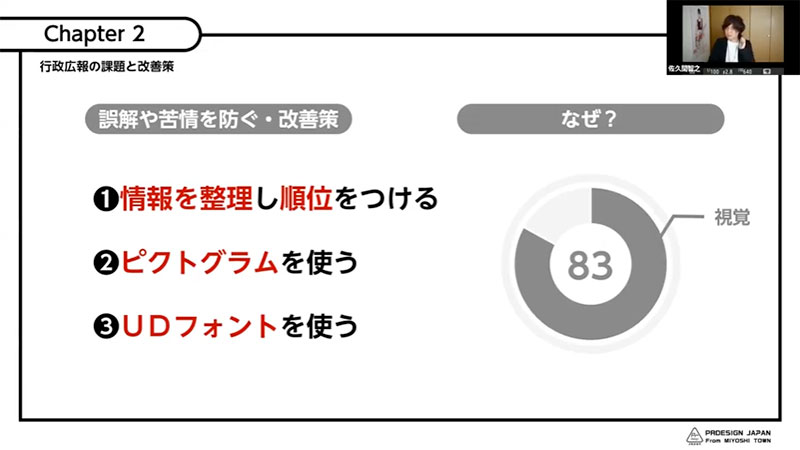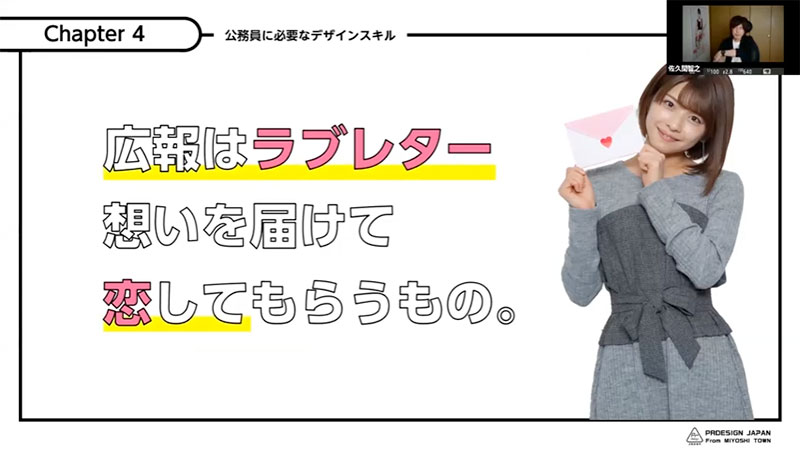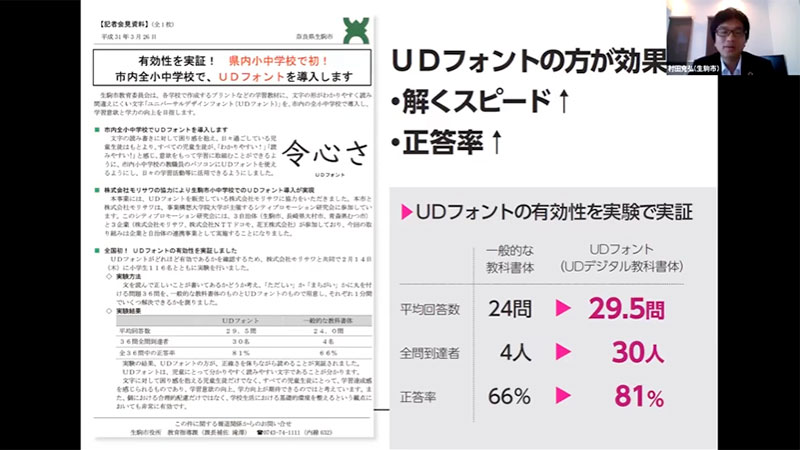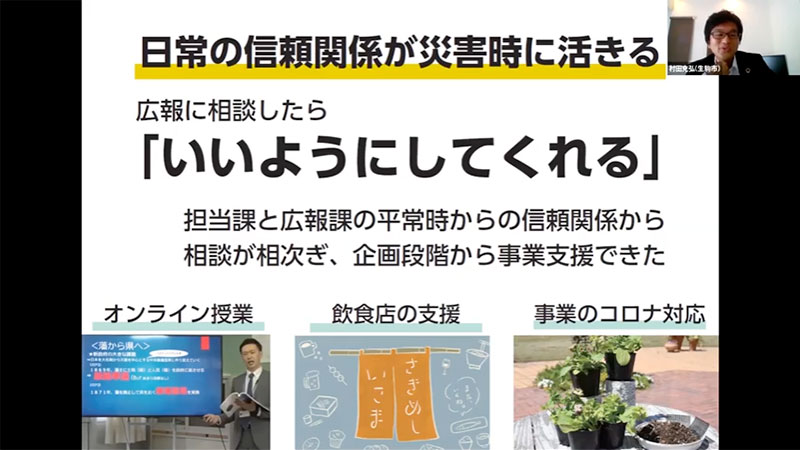
An online seminar for local governments titled "SDGs and Universal Design for Information for Regional Revitalization" was held on May 20th. Here we will provide a digest of the event!
Former PR Officer for Miyoshi Town, Saitama Prefecture / Public Relations Advisor for Nakano Ward, Tokyo
Tomoyuki Sakuma
What are the challenges and solutions for government public relations?
At the beginning of the event, Sakuma faced system issues unique to online communication, but continued to speak with the light-hearted tone of a popular TV personality. He pointed out that "during the COVID-19 pandemic, a gap emerged between what the government wanted to communicate and what residents wanted to know, which became a problem." He then presented three ways to ensure that the information disseminated is not misunderstood, with concrete examples.
① Ranking (e.g., special fixed-amount payment)
By displaying "To everyone" in a prominent place on the flyer, you can draw attention to the fact that "the cash benefit applies to me too." It is said that it is very important to prioritize what you communicate.
② Use pictograms (e.g., the 3 Cs)
The words "closely-spaced" and "closed" don't really give much meaning, but using pictograms makes them easier to understand. The trick is to include pictograms even if it's a bit of a stretch, as adding pictures naturally reduces the amount of text and condenses it, resulting in easier-to-understand PR materials.
3) Use UD fonts (e.g., how to take medicine)
It would be a problem if the correct dosage was three tablets, but it looked like eight. By using a "universal design font (UD font)" that is easy for many people to understand, it becomes easier to read and important, life-saving information can be delivered correctly.

What is needed in a post-COVID society?
Next, Sakuma spoke about the future of public relations magazines in the post-COVID era. During the COVID-19 pandemic, online communication has become commonplace. Many people are aware that in the future, opportunities to meet and talk in person will decrease and communication via smartphones and computers will become even more prevalent. In this context, it is important to "avoid creating information-poor people," which is also related to the SDGs.
Shibuya Ward and Miyoshi Town in Saitama Prefecture have already introduced UD fonts to make text easier to understand even on small screens like smartphones. Kimitsu City in Chiba Prefecture and Inabe City in Mie Prefecture have also adopted Morisawa's translation software "MC Catalog+." Supporting 10 languages, it makes it easier for foreigners of various nationalities living in Japan to access information.
"Cities that show careful consideration, such as by introducing pictograms and universal design fonts, will be chosen in the future," says Sakuma. For example, if someone sees eye-catching cancer screening materials, gets screened, and their life is saved, they will want to return even if they leave the city for a while. "Public relations is like a love letter, so it's important to convey your feelings and make people fall in love with it," he concludes.
Regarding Sakuma's materials, which were very easy to read, one participant asked, "Are you making them in PowerPoint?" Sakuma replied, "Yes, I am making them in PowerPoint. The reason they are easy to read is because I use UD fonts," emphasizing the importance of UD fonts.

Promotion Section Chief, Public Relations and Hearings Division, Mayor's Office, Ikoma City, Nara Prefecture
Mitsuhiro Murata
Universal design has evolved during the COVID-19 pandemic
Next, Murata spoke in a calm tone, giving an easy-to-understand explanation of Ikoma City's efforts. Ikoma City has been selected as an "SDGs Future City," and has introduced UD fonts to its elementary and junior high schools. When the effects were measured by having children take tests, he explained that the correct answer rate for regular fonts was 66%, while for UD fonts it was 81%. The number of correct answers also improved: 29.5 questions with UD fonts compared to 24 with regular fonts.
During the COVID-19 pandemic, Ikoma City received many complaints about its newsletter. Because there was a two-week lag between the deadline and printing, the city received comments such as "They seem to have a low sense of crisis," "The information is outdated," and "There is not enough information." To quickly gather information about COVID-19, which is constantly changing, the city revamped its system with the cooperation of its upper management. Since then, the city has been receiving timely information.
The website was also revamped to centralize COVID-19 information. Repeated analysis was carried out using Google Analytics to ensure the website delivers the latest information residents want to know. The banners were also slightly revised based on analysis of click rates, resulting in page views doubling compared to last year.

Not only is it easy to read, but the information itself is also easy to understand.
They also focused on disseminating information through analog means, asking post offices, convenience stores, pharmacies, supermarkets, and other places to place city leaflets about COVID-19. Because they already had cooperative relationships with these businesses, they were happy to let them place the leaflets. Upon hearing this, Sakuma couldn't help but comment, "After all, it's important to take action in peacetime."
It has long been said that if you consult with Ikoma City's public relations department, they will respond promptly, and they have received numerous consultations even during the COVID-19 pandemic. As a result, the Public Relations Department has been involved in online classes for schools and supporting restaurants. Ikoma City was actually the first to implement the "sakimeshi" program, which supports restaurants by paying in advance!
Murata stresses the importance of "universal design of information" in order to achieve the SDGs. Because the amount of information within Ikoma City Hall is vast and difficult to understand, the Public Relations Division receives it, digests it in an easy-to-understand way, and communicates it to the public. They then interview the public about what they didn't understand, and provide feedback to the city hall again.

One participant in this seminar commented, "I learned that the SDGs are fundamentally about making information easy to understand and making cities more livable." I'm sure the other participants also gained many insights.
